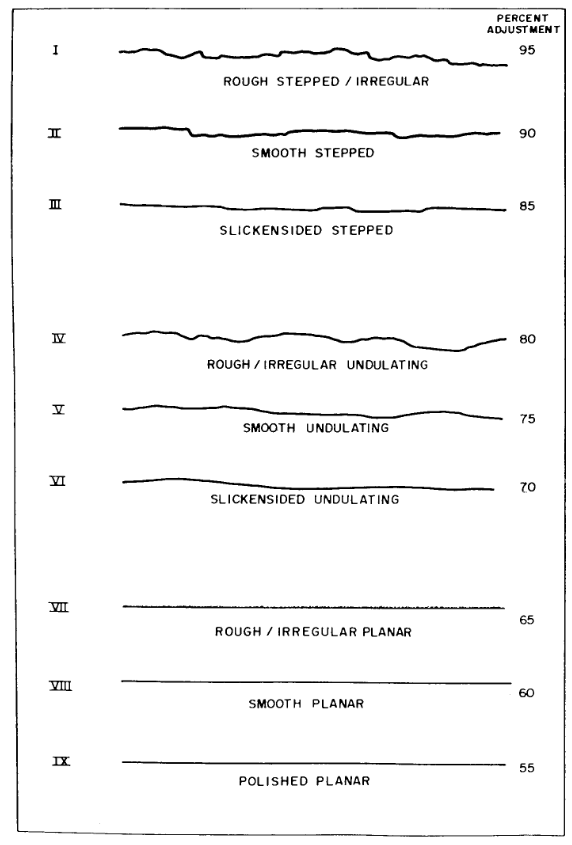MRMR 1990#
The “Mining Rock Mass Rating”, MRMR, system was first presented by Laubscher in 1977 [1], althought the commonly used first version is the one presented by himself in 1990 [2].
The following makes reference to the MRMR 1990’s version.
Parameters#
The following parameter descriptions are based on the 1990 version [2].
Intact rock strength#
IRS [MPa] Range |
Rating |
|---|---|
> 185 |
20 |
165–185 |
18 |
145–164 |
16 |
125–144 |
14 |
105–124 |
12 |
85–104 |
10 |
65–84 |
8 |
45–64 |
6 |
35–44 |
5 |
25–34 |
4 |
12–24 |
3 |
5–11 |
2 |
1–4 |
1 |
RQD#
Fracture Frequency#
Average per metre |
1 set |
2 set |
3 set |
|---|---|---|---|
0,10 |
40 |
40 |
40 |
0,15 |
40 |
40 |
40 |
0,20 |
40 |
40 |
38 |
0,25 |
40 |
38 |
36 |
0,30 |
38 |
36 |
34 |
0,50 |
36 |
34 |
31 |
0,80 |
34 |
31 |
28 |
1,00 |
31 |
28 |
26 |
1,50 |
29 |
26 |
24 |
2,00 |
26 |
24 |
21 |
3,00 |
24 |
21 |
18 |
5,00 |
21 |
18 |
15 |
7,00 |
18 |
15 |
12 |
10,00 |
15 |
12 |
10 |
15,00 |
12 |
10 |
7 |
20,00 |
10 |
7 |
5 |
30,00 |
7 |
5 |
2 |
40,00 |
5 |
2 |
0 |
Joint Condition#
Large-scale Expression#
“Sub-section A caters for the large-scale expression of the feature, such as across a drift or in a pit face.”
Description |
Dry |
Moist |
Mod. pressure (25–125 lt/m) |
High pressure (>125 lt/m) |
|---|---|---|---|---|
Multi wavy directional |
100 |
100 |
95 |
90 |
Uni wavy directional |
95 |
90 |
85 |
80 |
Curved |
85 |
80 |
75 |
70 |
Slight undulation |
80 |
75 |
70 |
65 |
Straight |
75 |
70 |
65 |
60 |
Small-scale Expression#
“B assesses the small-scale expression and is based on the profiles shown…”

Figure 2: Joint roughness profiles.#
Description |
Dry |
Moist |
Mod. pressure (25–125 lt/m) |
High pressure (>125 lt/m) |
|---|---|---|---|---|
Rough stepped/irregular |
95 |
90 |
85 |
80 |
Smooth stepped |
90 |
85 |
80 |
75 |
Slickensided stepped |
85 |
80 |
75 |
70 |
Rough undulating |
80 |
75 |
70 |
65 |
Smooth undulating |
75 |
70 |
65 |
60 |
Slickensided undulating |
70 |
65 |
60 |
55 |
Rough planar |
65 |
60 |
55 |
50 |
Smooth planar |
60 |
55 |
50 |
45 |
Polished |
55 |
50 |
45 |
40 |
Wall Strength Contrast#
“Section C is applied only when there is a distinct difference between the hardness of the host rock and that of the joint wall”
This means that Factor C is only activated or modified when there is a noticeable contrast in mechanical properties between:
The intact rock mass (host rock), and
The material or surface along the joints (joint walls), which might be altered, infilled, or weathered.
Description |
Dry |
Moist |
Mod. pressure (25–125 lt/m) |
High pressure (>125 lt/m) |
|---|---|---|---|---|
Joint wall alteration weaker than wall rock and only if it is weaker than the filling |
75 |
70 |
65 |
60 |
Infill#
Description |
Dry |
Moist |
Mod. pressure (25–125 lt/m) |
High pressure (>125 lt/m) |
|---|---|---|---|---|
Non-softening and sheared material – Coarse |
90 |
85 |
80 |
75 |
Non-softening and sheared material – Medium |
85 |
80 |
75 |
70 |
Non-softening and sheared material – Fine |
80 |
75 |
70 |
65 |
Soft sheared material (e.g., talc) – Coarse |
70 |
65 |
60 |
55 |
Soft sheared material (e.g., talc) – Medium |
60 |
55 |
50 |
45 |
Soft sheared material (e.g., talc) – Fine |
50 |
45 |
40 |
35 |
Gouge thickness < amplitude of irregularities |
45 |
40 |
35 |
30 |
Gouge thickness > amplitude of irregularities |
30 |
20 |
15 |
10 |